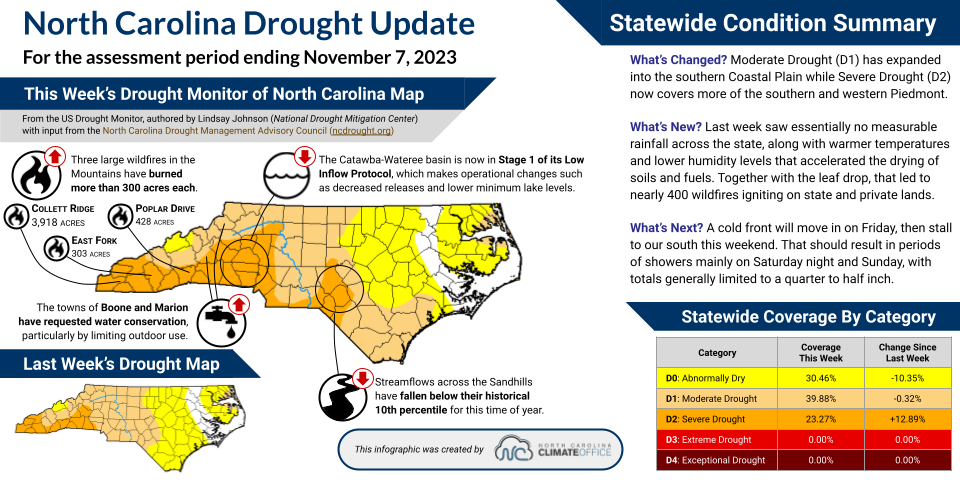Dry Weather, but Be Ready When It Does Rain
go.ncsu.edu/readext?969411
en Español / em Português
El inglés es el idioma de control de esta página. En la medida en que haya algún conflicto entre la traducción al inglés y la traducción, el inglés prevalece.
Al hacer clic en el enlace de traducción se activa un servicio de traducción gratuito para convertir la página al español. Al igual que con cualquier traducción por Internet, la conversión no es sensible al contexto y puede que no traduzca el texto en su significado original. NC State Extension no garantiza la exactitud del texto traducido. Por favor, tenga en cuenta que algunas aplicaciones y/o servicios pueden no funcionar como se espera cuando se traducen.
Português
Inglês é o idioma de controle desta página. Na medida que haja algum conflito entre o texto original em Inglês e a tradução, o Inglês prevalece.
Ao clicar no link de tradução, um serviço gratuito de tradução será ativado para converter a página para o Português. Como em qualquer tradução pela internet, a conversão não é sensivel ao contexto e pode não ocorrer a tradução para o significado orginal. O serviço de Extensão da Carolina do Norte (NC State Extension) não garante a exatidão do texto traduzido. Por favor, observe que algumas funções ou serviços podem não funcionar como esperado após a tradução.
English
English is the controlling language of this page. To the extent there is any conflict between the English text and the translation, English controls.
Clicking on the translation link activates a free translation service to convert the page to Spanish. As with any Internet translation, the conversion is not context-sensitive and may not translate the text to its original meaning. NC State Extension does not guarantee the accuracy of the translated text. Please note that some applications and/or services may not function as expected when translated.
Collapse ▲This is the third consecutive fall in Caldwell County that has been marked by dry conditions. Currently, I’d describe our situation as bone dry. The NC Drought Management Advisory Council classifies the conditions we are experiencing in Caldwell County as D1, with Southwestern Caldwell as D2. They define D1 as a moderate drought and D2 as a severe drought.
Unlike the past two years, when we escaped drought despite the typically drier La Niña pattern. Now we’re transitioning into an El Niño this winter, which typically brings hope for more sustained wetter weather. However, any substantial relief from the drought is forecasted to be in the long-term outlook. In the short term, little precipitation is expected through the end of November.
Of course, it will rain again; we just don’t know when. Nonetheless, there are measures you can take to maximize the benefits of the rain when it arrives. First, avoid mowing or grazing your fescue too short. Ideally, leaving 4 inches tall is best. When the grass reaches this height, it’s advisable to wait for rain. The fescue will recover much quicker if it’s not overgrazed or mowed too close.
To achieve maximum growth during the fall and early spring, fall is typically the season to fertilize fescue lawns, pastures, and hayfields. However, due to the current dry conditions, I would not recommend fertilizing at this time. Lime, however, can be applied if needed.
Our soils naturally become more acidic over time, which is why lime application is often necessary. Here are a few key points about lime:
- Lime is a soil amendment, not a fertilizer. Dolomitic lime contains calcium and magnesium, while calcitic lime only supplies calcium.
- Lime is available in powdered or pelletized form for easy application, and while liquid lime is an option, it typically represents a more costly method.
- Lime raises soil pH. Soils in our area tend to be clay-based and become more acidic over time. A pH of 7 is neutral; anything below 7 is acidic, and above 7 is alkaline.
- Though lime can be applied any time of the year, fall is the traditional season for its application.
- Most plants, including fescue and many garden vegetables, thrive in slightly acidic soils with a pH between 6.0 to 6.5.
- Certain plants, such as azaleas, rhododendrons, blueberries, and broomsedge, prefer even more acidic soils with a pH below 6.0.
- Both low and high soil pH levels can prevent plants from absorbing nutrients effectively.
Soil testing is the most reliable method to determine soil nutrient content and pH levels. It is a misconception that “you can’t put down too much lime” – indeed, excessive lime can be applied. I have seen several instances over the years where too much lime was causing a problem with plant growth in Caldwell County.
Applying lime or any other nutrient without soil testing can be harmful to plant health. Soil tests are conducted by the NC Department of Agriculture. Kits are available at the N.C. Cooperative Extension Center at 120 Hospital Ave, Lenoir, along with soil probes for sampling. Soil testing is essential for the correct application of lime and fertilizer. This service is free until the end of November, after which there is a $4 charge per sample.
A proper soil sample should be taken at a depth of 4 inches, which may be difficult in dry conditions. This depth corresponds to the effective rooting zone of grass and is the appropriate level for altering soil nutrient composition in lawns, pastures, and hayfields. For plowed gardens and fields, samples should match the depth of the plowed layer.
If you have questions about soil testing or any other agricultural concerns, please contact the N.C. Cooperative Extension, Caldwell County Center at (828) 757-1290 or visit us online.

Weekly North Carolina Drought Update created by the NC State Climate Office.
Special thanks to Darrell Blackwelder for collaboration on this article. Darrell is retired from North Carolina Cooperative Extension where he served as a horticulture agent and the Director of the N.C. Cooperative Extension,Rowan County Center.




